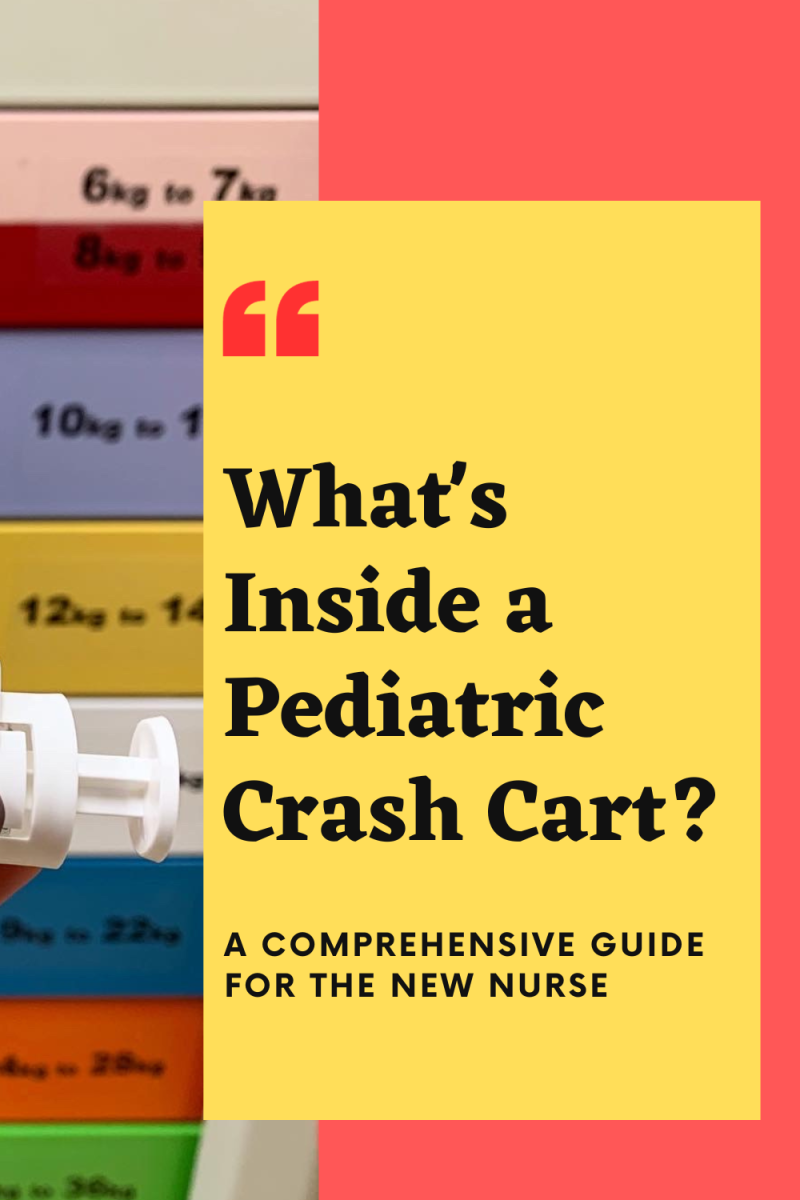What’s in a Pediatric Crash Cart? Nursing Students read NOW!

A pediatric crash cart is a mobile unit containing essential equipment and medications required for emergency care in pediatric patients. It is designed to be easily accessible and transportable to any location within a healthcare facility. Have you ever had a chance to actually look through a Pediatric Crash Cart? Most of us don’t until there is an actual code, and even then, there is no time to “browse”. Don’t fret my friends – I am going to break it down for you. Here’s a list of common tools found in a pediatric crash cart and their uses, explained in detail for you.
1. Defibrillator:
- Use:
- The defibrillator, shocker, huh? (no pun intended! hah), is used to administer an electric shock to the heart in the event of cardiac arrest or life-threatening arrhythmias. It helps restore a normal heart rhythm.
- Comes with:
- Defibrillation pads (various sizes) usually found on top of crash cart
- Tip: Getting certified in PALS is going to help you a ton in understanding the defibrillator and the pediatric crash cart in general. Feel free to visit AHA for more information on certifications.
2. Cardiac Monitor:
- Use:
- The cardiac monitor continuously displays the patient’s heart rate, rhythm, and other vital signs. It aids in the early detection of cardiac abnormalities and guides treatment. The cardiac monitor and defibrillator are both the same machine but within that machine are different functions. You can either choose to defibrillator or just use it as a monitor.
- Comes with:
- EKG leads packet
3. Bag-Valve-Mask (BVM) Resuscitator:
- Use:
- The BVM resuscitator is used for manual ventilation during respiratory distress or arrest. It delivers positive pressure breaths to the patient using a mask. You may know it as or hear it called an “ambu-bag” however, the correct and universal term is Bag-Valve-Mask or BVM. “Ambu-bag” is just the name of a brand of BVM’s. Get it? Good.
4. Endotracheal Tubes (ETTs) and Intubation Equipment:
- Use:
- ETTs are used for securing the airway by intubating the patient during respiratory failure or to protect the airway during certain medical procedures. Your pediatric crash cart will have various sized of ETT depending on the weight-based drawer you access.
5. Laryngoscope:
- Use:
- The laryngoscope is used to visualize the vocal cords and facilitate the insertion of an endotracheal tube during intubation. You usually have two types of Laryngoscope blades in your Pediatric crash cart.
6. Intravenous (IV) Access Supplies:
- Use:
- IV access supplies include catheters, saline flushes, and IV tubing. These are used to establish and maintain intravenous access for fluid administration and medication delivery. You will also find lab tubes inside the pediatric crash cart making it easier to quickly collect blood samples.
- Note:
- You will also have IO Access Supplies in the event you cannot obtain an IV. IO is access in the bone and is performed in emergency situations. There will be an IO drill and needle in the pediatric crash cart.
7. Medication Trays with Emergency Drugs:
- Use:
- Medication trays contain a variety of emergency medications commonly used in pediatric resuscitation, such as epinephrine, atropine, and vasopressors. Refer to my Emergency Medications You NEED to Know post for more information about medications housed inside the Pediatric Crash Cart.
8. Oxygen Delivery Devices:
- Use:
- Various oxygen delivery devices, such as masks, nasal cannulas, and non-rebreather masks, are available for providing supplemental oxygen to pediatric patients with respiratory distress.You will also find extra oxygen delivery mounts and christmas trees in case you are missing any. Don’t know what a “christmas tree” is? Here is a pic! You’ll never forget it now.
- Click here to learn all about the different oxygen delivery devices and when they are used.
9. Suction Equipment:
- Use:
- Suction equipment is used to clear the airway of secretions, blood or other fluids during respiratory distress or emergencies. This equipment includes a yankeur, suction catheters of various sizes and of course your suction canister which is usually found on the outside/side of your crash cart with a portable suction machine. Like the oxygen mount, you should also have an extra suction mount in the crash cart.
11. Crash Cart Labels and Emergency Protocol Guidelines:
- Use:
- Clearly labeled crash cart drawers and emergency protocol guidelines help healthcare providers quickly locate and use the necessary equipment and medications during an emergency.
- Note:
- Drawers have assigned a color and are labeled based on weight
12. Pediatric Emergency Tape:
- Use:
- Pediatric emergency tape provides weight-based dosing information for medications and interventions, helping ensure accurate administration in pediatric patients.
- TIP:
- If there are any extra Broselow tapes lying around, study this tape as it will tell you so much about the crash cart and medications for your pediatric patients.
13. Nasogastric (NG) Tubes and Supplies:
- Use:
- NG tubes and supplies are used for gastric decompression or administration of medications and enteral nutrition. You will find various sizes in the pediatric crash cart.
14. Airway Management Equipment:
- Use:
- This includes airway adjuncts such as oral and nasal airways, which can be used to maintain an open airway and facilitate ventilation.
15. CPR Board or Backboard:
- Use:
- A CPR board or backboard is used to provide a firm surface for effective chest compressions during cardiopulmonary resuscitation (CPR). It is usually found behind the pediatric crash cart.
16. Pediatric Crash Cart Checklist:
- Use:
- A checklist helps ensure that all necessary equipment and medications are available, not expired and in working order. Regular checks and restocking are crucial for preparedness. Crash cart checks are usually done every shift but this may vary based on
17. Gloves, Masks, and Personal Protective Equipment (PPE):
- Use:
- PPE is essential to protect healthcare providers from potential infectious agents during emergency procedures.
By understanding the tools in a pediatric crash cart and their uses, you will be able to contribute more effectively in a pediatric emergency situation, ensuring the best possible outcomes for your patient. Don’t forget to find out where the crash cart is located on your unit and anything you must know about it early on in your preceptorship. You GOT THIS!
Believing in you always,
The RN Educator
Share this:
Related Posts
7 Self Care Tips for Nurses to Practice Today
Self-care in nursing seems to be a practice many nurses and nursing students do…
Share this:
What to Do When Your Patient Has Supraventricular Tachycardia (SVT)
Today we are talkin’ what to do when your patient has Supraventricular Tachycardia. If…



